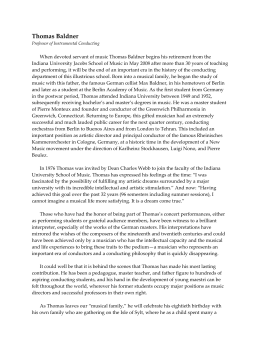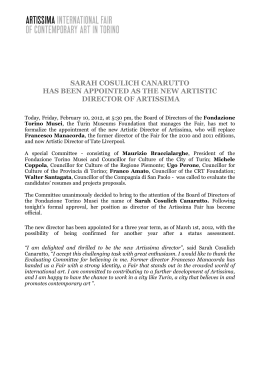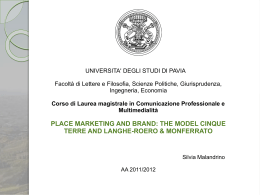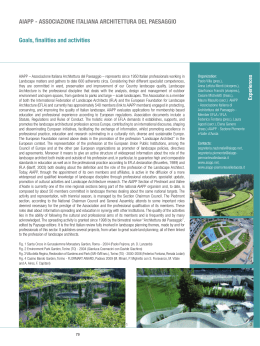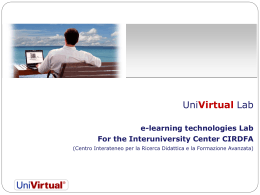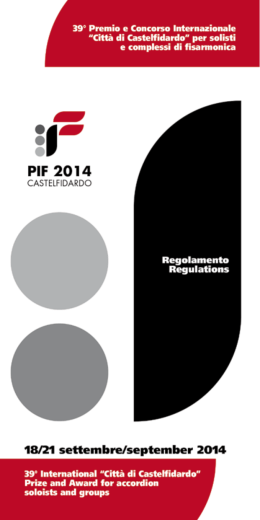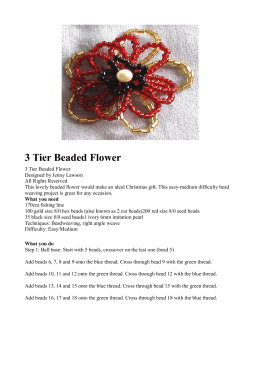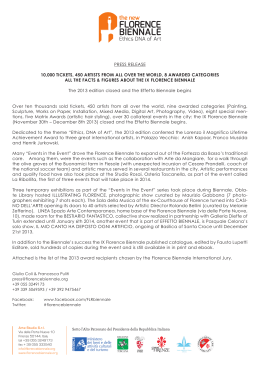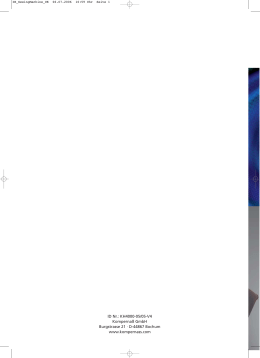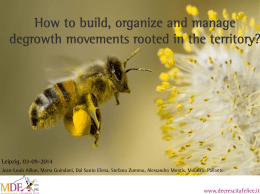A. PROJECT TITLE ARIADNE’S THREAD: ART AS CULTURAL IDENTITY From Regions to Europe ANNO EUROPEO DELLA LOTTA ALLA POVERTÀ E ALL’ESCLUSIONE SOCIALE IL FILO DI ARIANNA: ARTE COME IDENTITÀ CULTURALE Organizzazione: Associazione I.C.S. International Communication Society Sede Legale:Via Paolo Buzzi 46 E 00143 Roma Corrispondenza: P.O. Box 204 - Ufficio postale Piazza San Silvestro, 19 00187 Roma C.F. e IVA 03649021007 Tel.+39 06 70453308 Fax +39 06 77206257 e-mail: [email protected] sito web: icsociety.net B. OBJECTIVES ●In an increasingly complex society and therefore difficult to understand for too many interactions, there is the need to simplify, to find reading keys, metaphors and symbols for the information which has to be both communication and knowledge. In order to find out the meaning of things beyond words, to pass from subjective to objective, comprehensible and reproducible in the teaching-educational field, the project Ariadne’s Thread: Art as Cultural Identity, From Regions to Europe has been created. From different parts, in the last decade, we hear the words cultural identity referred to nations or Europe. However, if we need to pass on this concept, this value to young people and also the less young, the explanation becomes difficult. Therefore we started from a symbol, more symbols consisting of images which can draw from feelings and emotions, thus forming the basis of knowledge which unwinds through a thread, Ariadne’s Thread. The symbols and images are representations of the Italian artistic heritage, associated to the European one to find again our European cultural roots. ●We need to add the new communication technologies to this which give the tools to reach the project objectives. From the paper medium the horizon moves towards the web network, a fertile soil open to new experimentations towards already known or still to be explored issues. C. EDUCATION TO ARTS AND TRAINING “If arts and culture have received a greater European recognition in the last five years, the potential within the general EU strategies has to be still realised. Art and culture together with education, social protection and environmental sustainability are key factors to which we need to give a more important role in future European strategies. The need to have strong intelligent and well thought issues aimed at the defence of the role of arts and culture turns out to be more evident than ever. Beyond the immediate context of the financial crisis and the needs on our governments, there are some trends in our society that mainly enhance the economic factor rather than the social one, the individual well-being rather than the collective one. Arts need to be located inside a wider framework for the political change and can be at the vanguard for Europe in the next few years. (Ilona Kish, Secretary-General of Culture Action Europe). The practice, the support, the enhancement of skills and the formulation of development objectives for artistic education were the main topics of the 2nd World UNESCO Conference on Education to Arts which took place in Seoul, Korea, on May 25-28 2010. The 2,000 participants coming from more than 100 countries, 20 of which represented by the Ministers of Culture and/or Education discussed the Road Map of the Education to Arts. The last day of the conference was dedicated to the discussion and formulation of the development objectives for artistic education: • Affirm the artistic education as a basis for a balanced cognitive, emotional, aesthetic and social development of children and young people. • Strengthen the education to arts including the experience of arts and the collaboration with artists within both the school and out-of-school framework. • Give the possibility to artists and teachers to be trained in the field of sustainable artistic education. • Promote and favour the permanent learning both in the artistic education and through it. • Recognise and develop the socio-cultural dimension of the well-being of artistic education. • Support and enhance the role of artistic education in the promotion of social responsibility, social cohesion, cultural diversity and intercultural dialogue. • Build the skills for the processes of leadership, support and development of policies for artistic education. • Develop different partnerships for artistic education between individuals and sectors, from culture to industry. • Stimulate the dialogue and exchange between theory, research and practice in the field of artistic education 1 .A Communication of the Commission to the European Parliament, to the Council, to the European Economic and Social Committee and to the Committee of Regions entitled A new impetus for the European cooperation in the field of education and vocational training in support of the strategy Europe 2020 was written on 9 June 2010 in Brussels. The education and initial vocational training (IVET) has to endow young people with skills which can be used on the developing job markets such as the e-skills as well as higly developed key skills such as digital skills and media literacy which has to make it possible to young people to acquire a digital skill. Furthermore the IVET is fundamental in the fight against the high unemployment rate among young people in Europe. Furthermore VET is responsible for facing wider social challenges, as regards the promotion of social inclusion. It is important to give all working people the possibility to participate in the economic and social life through accessible and equal opportunities of education. D. DEVELOPMENT OF THE ROLE OF TEACHERS AND TRAINERS Teachers and trainers play a crucial role for the VET modernisation: the ways on how to be hired, the professional development and their social status deserve therefore a particular attention. As emerges from the present communication, a future full of changes such as the one upon us involves challenges for teachers and trainers of VET: these are challenges relevant to new teaching methods, to the development of study programmes, to the guarantee of qualities as well as to the management and administration tasks. The roles of teachers and trainers have many things in common: the trainer active in the job world has to acquire major pedagogical skills and develop a role of support and guide, whereas a teacher in school must have a better understanding of the work procedures similar to those adopted by trainers. Such convergence should have an impact on the recruiting strategies and on a constant improvement of attitudes and skills which should then be strengthened and mirrored in their professional status. By sharing this thought, we think that the project “Ariadne’s Thread” will increasingly have to link to the educational structures present on our territory, schools first of all but also the other public and private educational centres. E. SHORT PROJECT DESCRIPTION Starting form the above-mentioned considerations and from the results of the experimentation carried out from 2004 with the project “Ariadne’s Thread: Art as Cultural Identity, from Regions to Europe” which allowed a considerable number of schools to activate educational and cultural itineraries which led the students to the knowledge and enhancement of their own territory, starting from the identity consisting of the artistic heritage, the Association I.C.S. International Communication Society, in collaboration with public and private bodies, launches for the next three years the project “Young people as interpreters and ambassadors of cultural identities” articulated in: ●Annual contests at national and European level which invite young students to “create their own Ariadne’s Thread: from art to science through the history of the territory”, that is to know and enhance their own territory starting from one or more identifiable elements of it. ●From here the creation of “Cultural Identity Routes” expressed in multimedia form (CD and DVD) and if necessary also in paper, starting from the artistic and cultural “symbols” present in the territory, by also comparing them with National and European culture which can be used not only by young students but also by other categories of users from any social class and age, within the framework of permanent education and universities of the third age. ●At the same time the website www.CulturalIdentity.eu can be visited in Italian and English with the indication of “symbols” which highlight the cultural identity of the EU Countries. ●As regards Italy there will be the Cultural Identity Routes and periodical information will be given in Italian and English on different Exhibitions and Cultural Events which can involve many users and be an educational support to school programmes. E. INFORMATION AND REFERENCES For any further information, please send an e-mail to: [email protected], or a fax to:0039 0677206257. 2 ITALY CONTEST NOTICE 2010/2011 NETWORK OF CULTURAL IDENTITIES YOUNG PEOPLE AS INTERPRETERS AND AMBASSADORS OF CULTURAL IDENTITIES Create your own Ariadne's Thread: from art to science through the history of the territory The Association I.C.S. International Communication Society promotes the 2011 Session of the research project “Ariadne's Thread: Art as Cultural Identity, from Regions to Europe”, with the support of the Presidency of the Council of Ministers and in collaboration with the Ministry of Education, University and Research and with public and private bodies. The following research themes are suggested: 1. CREATE THE MENTAL MAP OF YOUR TERRITORY: FROM IMAGE TO MULTIMEDIA HYPERTEXT A mental map draws from all your mental skills: the association and imagination ones coming from your memory; words, numbers, lists, sequences, logic and analysis linked to the left side of the brain; colour, images, sizes, rhythm, daydreams, the awareness of the space linked to the right side of the brain; the power of the eyes to perceive and assimilate; the power of hands to reproduce with greater skill what the eyes have seen and the power of the brain to organise, store and retrieve what it has learnt. General indications: 1. Put a colourful image in the centre of a page (in this case an image linked to the artistic and cultural heritage of your territory). 2. The main ideas are developed from the centre under the form of ramifications. 3. An only word – capital -for each branch. Every word activates a huge number of associations and this rule gives each of them the freedom to form other associations in your brain. 4. The branches should be always connected with the previous and following ones. 5. It is opportune to use as many images as possible. 6. Change sizes whenever possible. 7. Use numbers or codes, lists, connections, arrows, symbols, numbers, letters, images, colours, sizes, underlinings of the outlines. 8. The map allows a multidirectional reading of the territory because experiences and stories, languages and works, signs and words are stratified in it. 9. Hence the reading and the building of a multimedia hypertext, a system of information subdivided into more blocks of contents not connected in a sequential way but according to hierarchies and logical connections which the reader can visit: it simulates a walk through an architecture of information which does not propose an itinerary with a beginning. 10. It is important to have a passage from the paper to the multimedia (CD Rom or DVD) because it makes powerpoint, image galleries and short films possible to be put. 2. YOUNG PEOPLE ON THE TRAIN TO DRAW THE IDENTITY OF THE LANDSCAPE (in collaboration with Fondazione Cardinale Cusano onlus); One of the major attractions of our Country is represented by the landscape. What mostly struck the visitors in transit to the Peninsula since the ancient times is the way how the Italians have managed to respect the natural beauties despite the fact they built cities, ports, monasteries, Patrician villas, bridges and roads. Every landscape reflects the society which produces it and every society projects in it cultures, values, identities which belong to it. Through culture, seen as a system of values and signs, men face their own environment by giving it a particular identity: the local landscape can be considered a vehicle of cultural identity which “speaks” of the society which is its creator. Which better way to taste the landscape of the train? Journeys on a train and railway stations have always fascinated artists and aroused in painters, writers, illustrators, singers, photographers, poster designers, cineastes, the desire to reproduce with their specific arts that changing, dynamic and evocative microcosm which characterises this way of travelling. This means of transport has often had lots of impact on the individual and collective imagination, touching on emotional metaphors and nuances of the most disparate human stories. Following some considerations the following themes of itineraries with practical exemplifications have been created: 1. Cross itineraries: the History and the Landscape Example: From Risorgimento to the Unity of Italy: Lombardy-Piedmont-Veneto 2. Cross itineraries: the Places and the Sacred Example: Terni-Sulmona-Rieti (Umbria-Lazio-Abruzzo) 3. Cross itineraries: the unknown Realities and the Nature Example: Sardinia (inside) 4. Cross itineraries: Cultural Heritage and Enhancement Example: Sicily (Agrigento-Enna) 5. Cross itineraries: the Linguistic Minorities and Cultures 3 Example: Trieste-Gorizia-Udine (Tarvisio) 6. Cross itineraries: Myth and Legends Example: Cumae and Phlegraean Fields The contest is divided into 2 sections: “Giovanintreno” (Young people on train) given to young people through Schools and Universities in order to realise the indicated or created itineraries; “Dalfinestrino” (From the window): drawings, photos, realisations with any technique which identify the landscape as is seen from the window in the itineraries made. The best works will create a cyber murales which can be seen on the website and printed on various materials in copies to be put for example in the train stop stations of the itinerary involved. A possibility will be given to schools which couldn't submit their works in the 2009/2010 edition of the project because of lack of time (regional elections) to finish it and submit it by the deadline of 15 May 2011. Participation in the 2010/2011 contest Students from primary schools (10-14 years old) and secondary ones (14-18 years old) as well as from Universities (19-24 years old) are invited to take part in it. The works can be made through new communication technologies (Cd Rom, Internet, Video) as well as through the traditional paper product (in this case we also ask for the realisation of a summary in PowerPoint). The product should have a short summary of at most one file and a bibliography and sitography limited at most to two indications. No more than 2 works for each school can be admitted to the selection. The presentation of all multimedia works should have a short summary in digital and paper. Comunications Entry by 15th December 2010 Send works by 15th May 2011 The events for 2010 Cultural Identity Days will take place from October to November. Upon receiving the entry form enclosed, a participation form will be sent. This latter has to be sent together with the work. Information: The Ministry of Education, University and Research as well as the collaborating bodies will take care of disseminating the contest in their websites. It can also be found in the website www.CulturalIdentity.eu of the Association I.C.S. For any further information we invite to use the e-mail address: [email protected] Selection: A jury qualified in different sectors of Italian culture and new technologies supported by the Representatives of the Regions where the final event will take place will select the best works which will be presented in local and national events where they will be given awards. They will then be put in the Internet site www.CulturalIdentity.eu dedicated to the Project Ariadne’s Thread which can be a sort of manual for activities of research and educational in-depth analyses with the possibility of being a real project in progress open to dialectics between schools and institutions, a place of synergy whose main aim is to give voice to the liveliest voices in the world of school and to contribute to their autonomous expression. Coordinating Body Associazione ICS International Communication Society, P.O. Box 204, Ufficio Postale Piazza San Silvestro, 19 - 00187 Roma. Tel. +390670453308; fax +390677206257; e-mail: [email protected] . website: www.icsociety.net; www.culturalidentity.eu 4
Scarica
